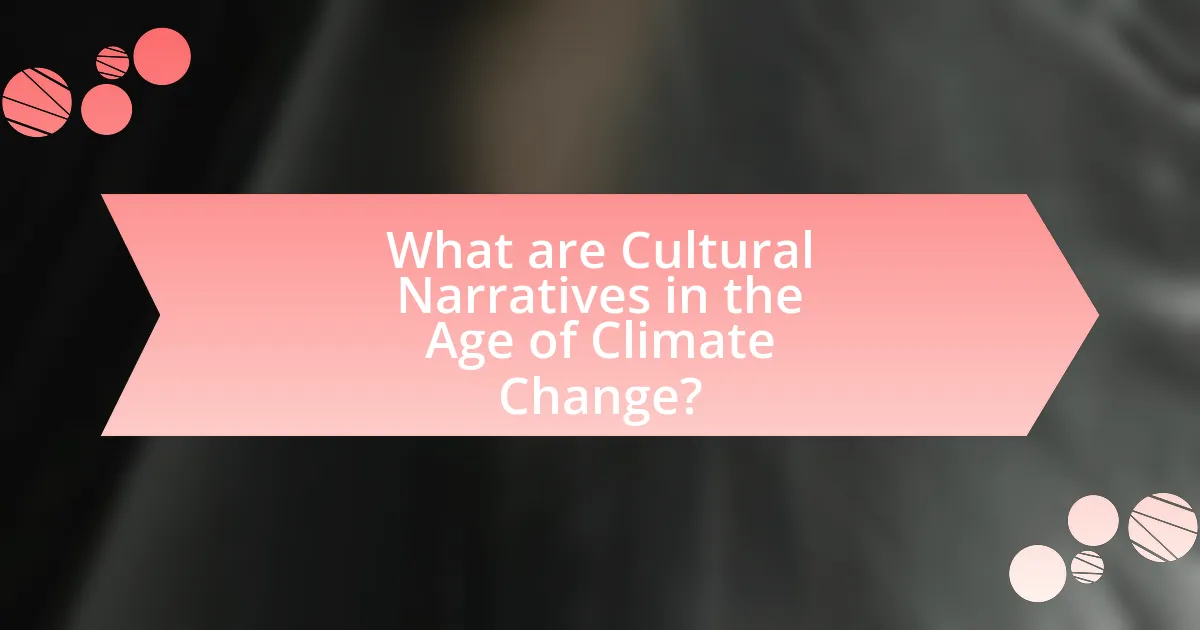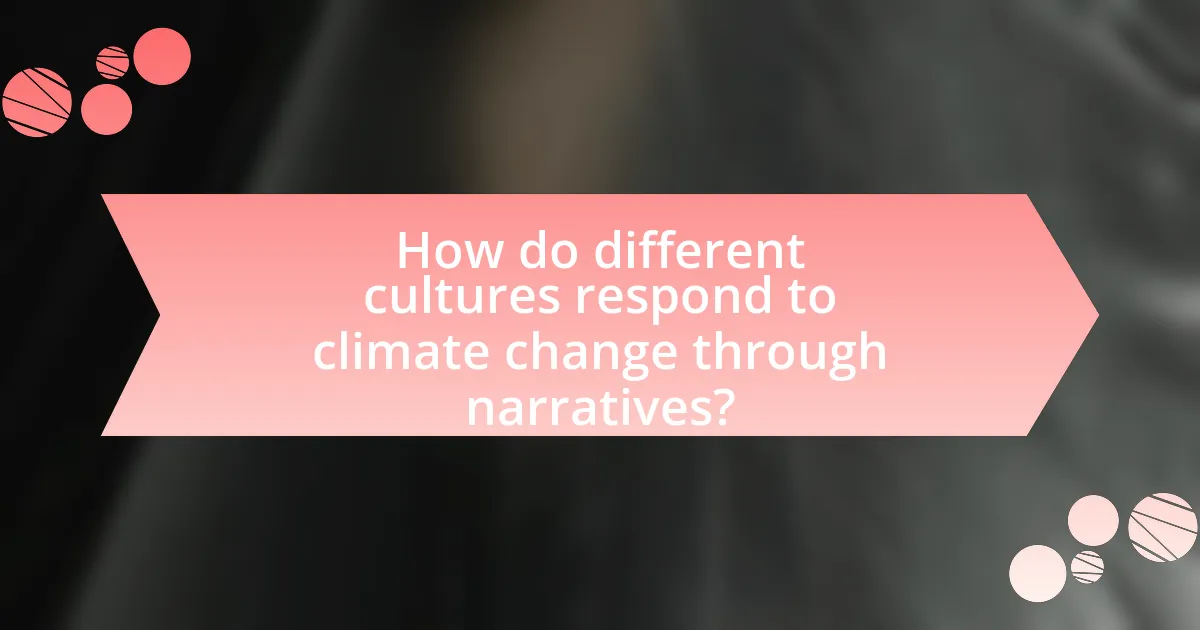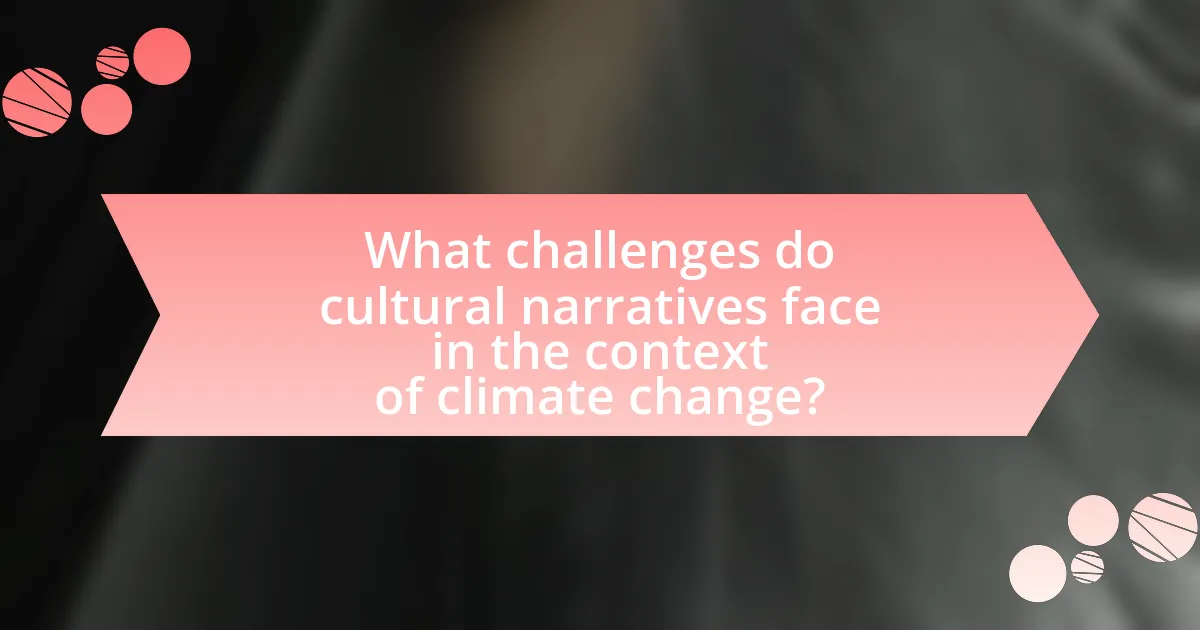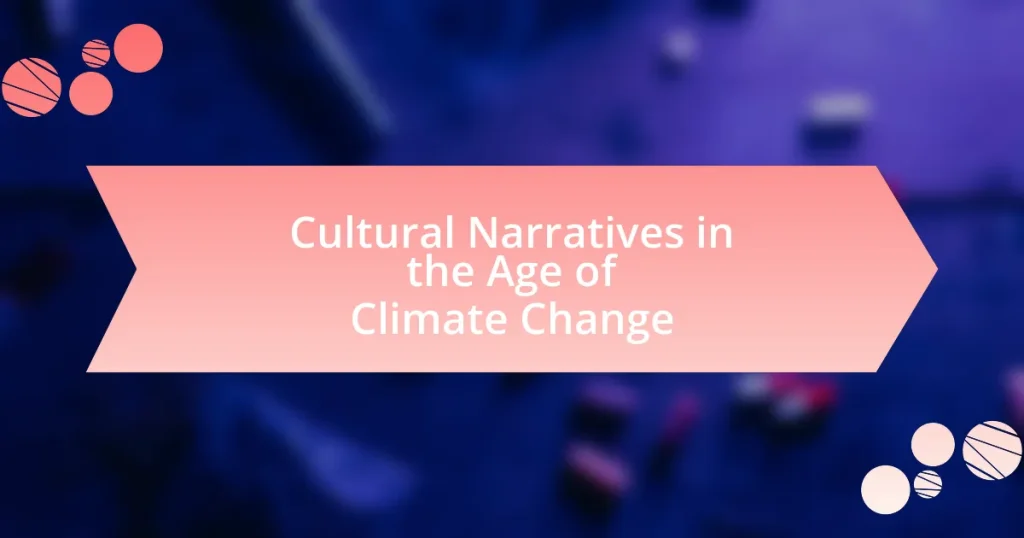Cultural narratives in the age of climate change refer to the stories and frameworks that societies utilize to comprehend and respond to climate impacts. These narratives significantly influence public perception, policy-making, and individual behaviors regarding environmental issues, with varying effects across different cultures. The article explores how cultural narratives shape understanding and engagement with climate change, the role of storytelling in fostering awareness, and the challenges posed by misinformation and climate denialism. It also examines the impact of technology and social media on these narratives, highlighting the importance of culturally resonant communication in promoting climate action and community resilience.

What are Cultural Narratives in the Age of Climate Change?
Cultural narratives in the age of climate change are the stories and frameworks that societies use to understand and respond to the impacts of climate change. These narratives shape public perception, influence policy decisions, and guide individual behaviors regarding environmental issues. For instance, narratives emphasizing urgency and collective action can mobilize communities towards sustainability, while those that downplay the crisis may hinder effective responses. Research indicates that cultural narratives can significantly affect climate change communication and engagement, as seen in studies by the Intergovernmental Panel on Climate Change, which highlight the role of storytelling in fostering awareness and action.
How do cultural narratives shape our understanding of climate change?
Cultural narratives significantly shape our understanding of climate change by framing the issue within specific societal values and beliefs. These narratives influence public perception, policy-making, and individual behavior regarding environmental issues. For instance, narratives that emphasize human responsibility for the planet can lead to increased support for sustainable practices, while those that portray climate change as a distant or abstract problem may result in apathy and inaction. Research by the Yale Program on Climate Change Communication indicates that cultural values, such as individualism versus collectivism, directly affect how different communities respond to climate change, highlighting the role of cultural context in shaping environmental attitudes and actions.
What role do stories play in influencing public perception of climate issues?
Stories play a crucial role in shaping public perception of climate issues by providing relatable narratives that connect individuals emotionally to the subject. These narratives often humanize abstract concepts, making the impacts of climate change more tangible and urgent. For instance, research by the Yale Program on Climate Change Communication indicates that personal stories about climate-related experiences can significantly increase concern and motivate action among audiences. By framing climate issues within the context of personal experiences or community impacts, stories can effectively alter perceptions and drive public engagement.
How do cultural narratives differ across various societies regarding climate change?
Cultural narratives regarding climate change differ significantly across societies, influenced by historical, economic, and social contexts. For instance, Indigenous communities often frame climate change as a spiritual and existential threat, emphasizing a deep connection to the land and traditional ecological knowledge. In contrast, industrialized nations may focus on technological solutions and economic impacts, viewing climate change primarily as a policy and market challenge. Research by the Intergovernmental Panel on Climate Change (IPCC) highlights that these varying narratives shape public perception and response strategies, with Indigenous perspectives often advocating for conservation and sustainability, while Western narratives may prioritize innovation and adaptation. This divergence in cultural narratives affects how communities mobilize for climate action and engage with policy frameworks.
Why are cultural narratives important in addressing climate change?
Cultural narratives are important in addressing climate change because they shape public perception and influence behavior towards environmental issues. These narratives provide context and meaning to climate data, making complex scientific information more relatable and actionable for individuals and communities. For instance, storytelling can evoke emotional responses that motivate collective action, as seen in movements like Fridays for Future, which leverage personal stories to highlight the urgency of climate action. Furthermore, cultural narratives can foster a sense of identity and belonging, encouraging communities to adopt sustainable practices that align with their values and traditions. This is supported by research indicating that culturally resonant messages are more effective in promoting pro-environmental behaviors than purely factual approaches.
What impact do these narratives have on policy-making and activism?
Cultural narratives significantly influence policy-making and activism by shaping public perception and mobilizing collective action. These narratives frame climate change as an urgent issue, prompting policymakers to prioritize environmental legislation and allocate resources for sustainability initiatives. For instance, the narrative of climate justice has led to policies that address inequalities exacerbated by climate change, as seen in the Green New Deal in the United States, which aims to create jobs while reducing carbon emissions. Additionally, grassroots movements, such as Fridays for Future, leverage these narratives to galvanize youth activism, resulting in increased public awareness and pressure on governments to act. This interplay between narratives and action demonstrates how storytelling can drive systemic change in response to climate challenges.
How can cultural narratives foster community resilience in the face of climate challenges?
Cultural narratives can foster community resilience in the face of climate challenges by shaping collective identities and promoting adaptive behaviors. These narratives often draw on shared histories, values, and experiences, which can unite individuals and encourage collaborative responses to environmental threats. For instance, communities that share stories of past resilience, such as overcoming natural disasters, are more likely to engage in proactive measures like disaster preparedness and sustainable practices. Research indicates that communities with strong cultural narratives exhibit higher levels of social cohesion and resource sharing, which are critical for effective response and recovery during climate-related events.

How do different cultures respond to climate change through narratives?
Different cultures respond to climate change through narratives by framing their experiences, values, and beliefs in ways that resonate with their unique contexts. For instance, Indigenous cultures often emphasize a deep connection to the land and the importance of stewardship, using storytelling to convey traditional ecological knowledge and the impacts of climate change on their communities. In contrast, Western narratives may focus on technological solutions and economic implications, highlighting innovation and policy changes as key responses. Research indicates that these narratives shape public perception and influence climate action; for example, a study by the Yale Program on Climate Change Communication found that culturally resonant narratives can significantly increase engagement and support for climate initiatives. Thus, the way cultures articulate their narratives around climate change directly affects their collective response and adaptation strategies.
What are some examples of cultural narratives from indigenous communities?
Cultural narratives from indigenous communities often include creation stories, oral histories, and teachings that reflect their relationship with nature. For example, the Navajo creation story emphasizes harmony with the Earth and the importance of balance in the natural world. Similarly, the Maori of New Zealand share narratives about their ancestors, which highlight the interconnectedness of people and the environment, as seen in the concept of “kaitiakitanga,” or guardianship of the land. These narratives serve to convey values, traditions, and ecological knowledge, reinforcing the significance of sustainable practices in the face of climate change.
How do these narratives reflect traditional ecological knowledge?
These narratives reflect traditional ecological knowledge by embodying the wisdom and practices developed over generations in specific cultural contexts. They often illustrate the deep understanding of local ecosystems, including species interactions, seasonal changes, and sustainable resource management. For example, Indigenous stories frequently emphasize the importance of biodiversity and the interconnectedness of life, which aligns with ecological principles recognized in modern science. This knowledge is validated by research showing that traditional practices, such as rotational farming and controlled burns, enhance ecosystem resilience and biodiversity, demonstrating the practical application of these narratives in addressing contemporary environmental challenges.
What lessons can be learned from indigenous narratives in climate action?
Indigenous narratives in climate action teach the importance of interconnectedness between humans and nature. These narratives emphasize sustainable practices and respect for the environment, rooted in centuries of traditional ecological knowledge. For instance, many indigenous communities advocate for land stewardship that prioritizes biodiversity and ecosystem health, which has been shown to enhance resilience against climate change impacts. Research indicates that indigenous-managed lands often exhibit greater biodiversity and lower carbon emissions compared to conventionally managed areas, highlighting the effectiveness of these approaches in climate mitigation and adaptation.
How do contemporary narratives in popular media address climate change?
Contemporary narratives in popular media address climate change by integrating it into storytelling across various genres, emphasizing its urgency and impact on society. Films, television shows, and literature often depict dystopian futures or environmental crises, illustrating the consequences of inaction. For instance, the documentary “Our Planet” highlights the effects of climate change on ecosystems, while fictional works like “The Day After Tomorrow” dramatize potential disasters to raise awareness. These narratives serve to educate audiences, provoke emotional responses, and inspire action, reflecting a growing recognition of climate change as a critical global issue.
What themes are prevalent in films and literature about climate change?
Prevalent themes in films and literature about climate change include environmental degradation, human resilience, and the moral responsibility to future generations. Environmental degradation is often depicted through narratives showcasing the consequences of pollution, deforestation, and extreme weather events, highlighting the urgent need for action. Human resilience is illustrated through characters who adapt to changing environments, emphasizing hope and innovation in the face of adversity. Additionally, the theme of moral responsibility is frequently explored, urging audiences to consider the ethical implications of their actions on future generations, as seen in works like “The Overstory” by Richard Powers, which intertwines personal stories with ecological awareness. These themes collectively reflect societal concerns and the pressing need for climate action.
How do these narratives influence public engagement with climate issues?
Cultural narratives significantly influence public engagement with climate issues by shaping perceptions and motivating action. These narratives frame climate change as a pressing social and moral issue, encouraging individuals to participate in advocacy and sustainable practices. For instance, storytelling that highlights personal experiences with climate impacts can evoke emotional responses, leading to increased awareness and community involvement. Research by the Yale Program on Climate Change Communication indicates that narratives emphasizing local effects of climate change can enhance public concern and support for climate policies, demonstrating the power of culturally resonant storytelling in mobilizing collective action.

What challenges do cultural narratives face in the context of climate change?
Cultural narratives face significant challenges in the context of climate change, primarily due to the clash between scientific evidence and deeply held beliefs. These narratives often struggle to incorporate the urgency of climate science, as many cultures prioritize traditional stories and values that may not align with contemporary environmental realities. For instance, research indicates that communities with strong cultural ties to land may resist scientific data that contradict their historical experiences, leading to a disconnect between local practices and necessary climate action. Additionally, misinformation and political polarization further complicate the acceptance of climate narratives, as individuals may reject facts that conflict with their ideological views. This resistance can hinder collective efforts to address climate change effectively, demonstrating the critical need for culturally sensitive communication strategies that bridge the gap between scientific understanding and cultural beliefs.
How do misinformation and climate denialism affect cultural narratives?
Misinformation and climate denialism significantly distort cultural narratives by promoting false beliefs about climate change, which undermines public understanding and action. This distortion occurs as misinformation spreads through various media, leading to confusion and skepticism among the public regarding scientific consensus. For instance, studies show that individuals exposed to climate denial messages are less likely to support climate policies, as evidenced by a 2019 report from the Yale Program on Climate Change Communication, which found that misinformation can decrease public concern about climate issues by up to 20%. Consequently, these altered narratives hinder collective efforts to address climate change, perpetuating a cycle of inaction and misunderstanding within society.
What strategies can be employed to counteract misinformation?
To counteract misinformation, strategies such as promoting media literacy, fact-checking, and fostering open dialogue can be employed. Media literacy education equips individuals with the skills to critically evaluate information sources, reducing susceptibility to false claims. Fact-checking organizations, like Snopes and FactCheck.org, provide verified information that can debunk myths and clarify misconceptions. Additionally, fostering open dialogue encourages discussions that allow individuals to share perspectives and correct misinformation in a constructive manner. Research indicates that these strategies can significantly reduce the spread of misinformation, as seen in studies conducted by the Pew Research Center, which highlight the effectiveness of media literacy programs in improving critical thinking skills among participants.
How can narratives be adapted to combat climate denialism effectively?
Narratives can be adapted to combat climate denialism effectively by emphasizing personal stories and local impacts of climate change. This approach engages audiences emotionally, making the issue more relatable and urgent. Research indicates that personal narratives can increase empathy and understanding, as demonstrated in a study by the Yale Program on Climate Change Communication, which found that individuals are more likely to change their beliefs when presented with relatable stories rather than abstract data. By focusing on local experiences and community-level consequences, narratives can bridge the gap between scientific consensus and public perception, fostering a more informed and proactive response to climate change.
What role does technology play in shaping cultural narratives about climate change?
Technology plays a crucial role in shaping cultural narratives about climate change by facilitating the dissemination of information and influencing public perception. Digital platforms, such as social media and websites, enable rapid sharing of climate-related data, research findings, and personal stories, which can alter how communities understand and engage with climate issues. For instance, the use of interactive data visualizations and mobile applications has made complex climate science more accessible, allowing individuals to grasp the urgency of climate change. Studies show that social media campaigns can significantly increase awareness and mobilize action, as seen in movements like Fridays for Future, which gained momentum through online platforms. This demonstrates that technology not only informs but also empowers individuals and groups to advocate for climate action, thereby reshaping cultural narratives around the urgency and importance of addressing climate change.
How can social media amplify or distort cultural narratives?
Social media can amplify or distort cultural narratives by rapidly disseminating information and shaping public perception. The platforms enable users to share stories, images, and opinions widely, which can enhance visibility for certain narratives, particularly those that resonate emotionally or align with popular sentiments. For instance, during climate change discussions, social media campaigns like #FridaysForFuture have mobilized global awareness and action, illustrating how collective voices can amplify cultural narratives around environmental issues. Conversely, misinformation can spread just as quickly, distorting narratives by promoting false or misleading information, such as climate change denial, which can undermine scientific consensus and public understanding. Research by the Pew Research Center indicates that 64% of Americans believe social media has a mostly negative effect on the way things are going in the country today, highlighting concerns about the distortion of cultural narratives through the spread of misinformation.
What are the implications of digital storytelling for climate activism?
Digital storytelling significantly enhances climate activism by creating emotional connections and raising awareness about climate issues. This form of narrative allows activists to share personal experiences and impactful stories that resonate with diverse audiences, making complex scientific data more relatable. For instance, studies show that narratives can increase empathy and motivate action; a report by the Yale Program on Climate Change Communication indicates that storytelling can lead to a 20% increase in public engagement with climate issues. Furthermore, digital platforms enable widespread dissemination of these stories, amplifying their reach and fostering community engagement. This combination of emotional appeal and broad accessibility positions digital storytelling as a powerful tool in the climate activism landscape.
What practical steps can individuals take to contribute to positive cultural narratives about climate change?
Individuals can contribute to positive cultural narratives about climate change by actively engaging in community education and advocacy. By organizing or participating in local workshops, individuals can share knowledge about sustainable practices and the importance of climate action. Research shows that community-led initiatives can significantly influence public perception and behavior regarding environmental issues. For instance, a study published in the journal “Nature Climate Change” found that grassroots movements effectively shift cultural narratives by fostering a sense of collective responsibility and empowerment. Additionally, individuals can utilize social media platforms to amplify positive stories and solutions related to climate change, thereby reaching a broader audience and encouraging collective action.
